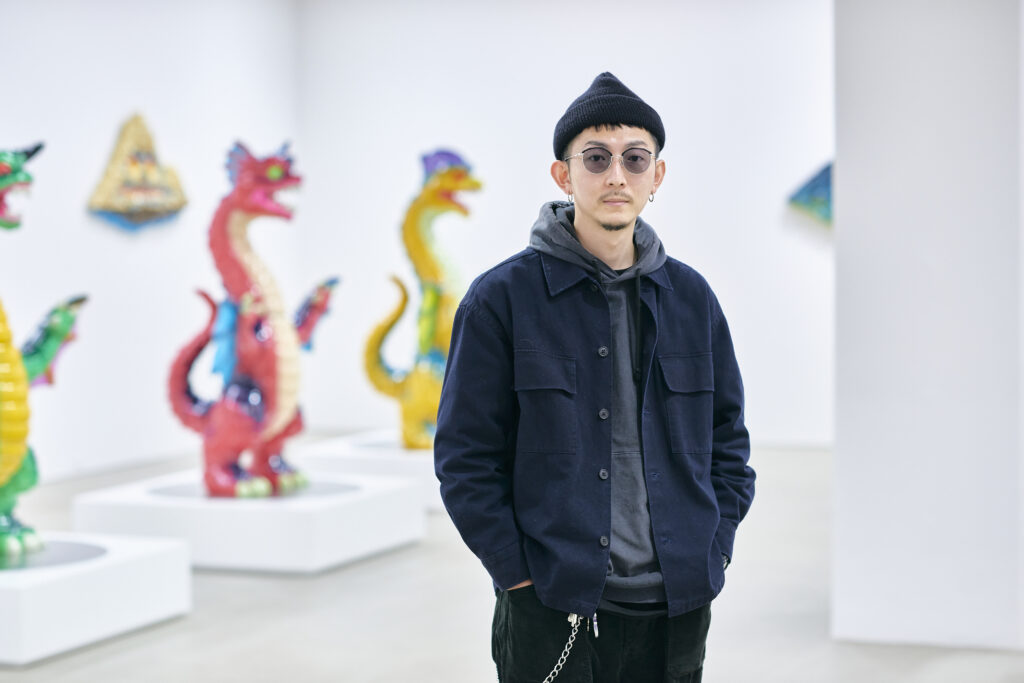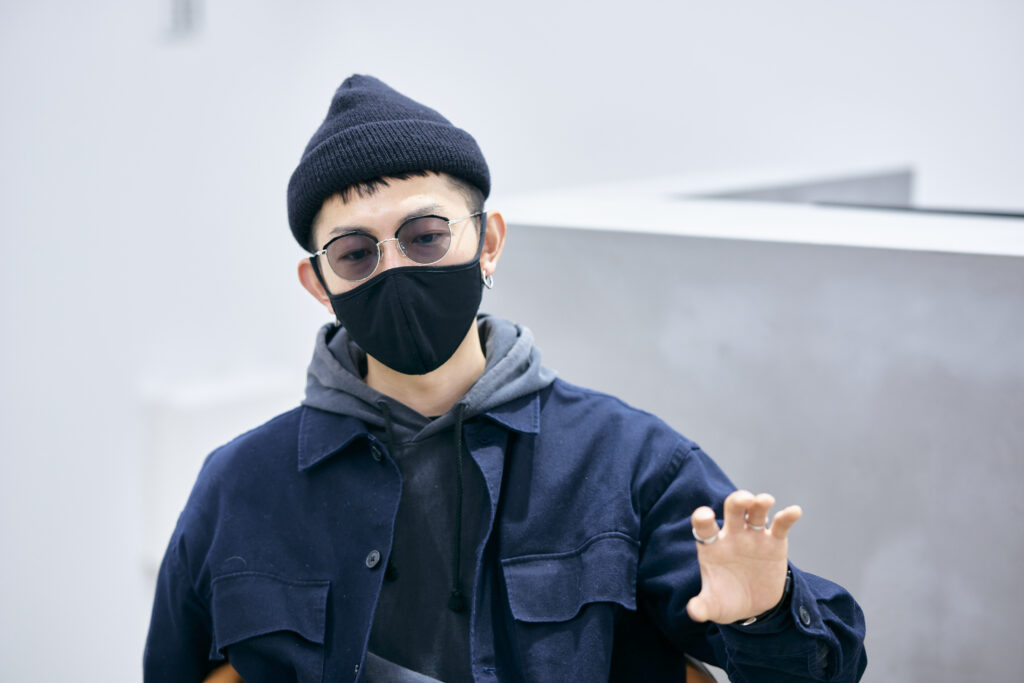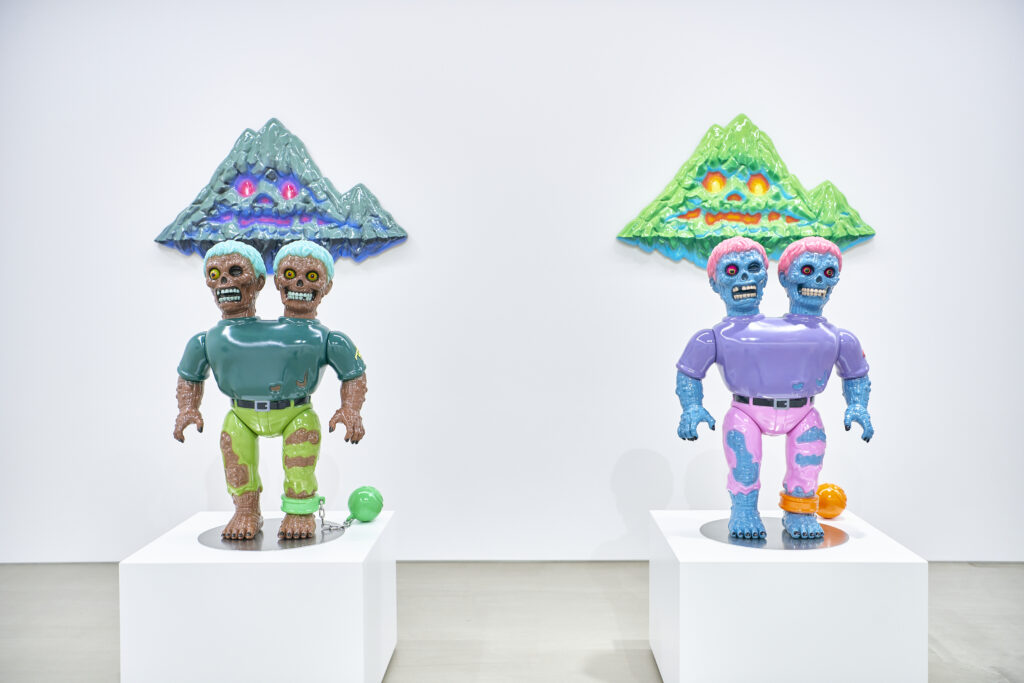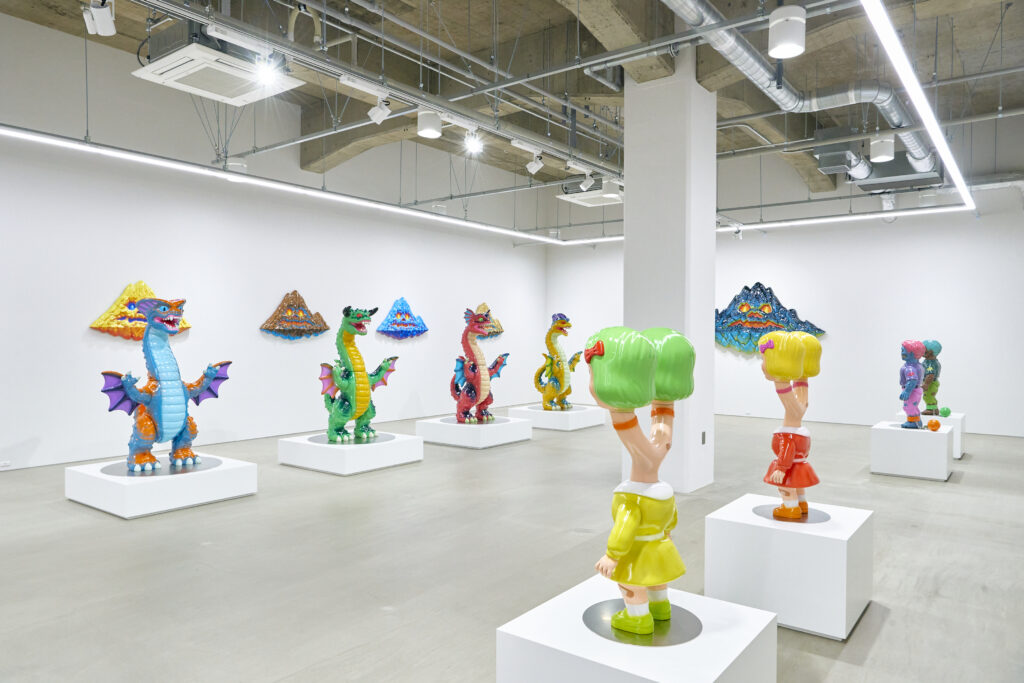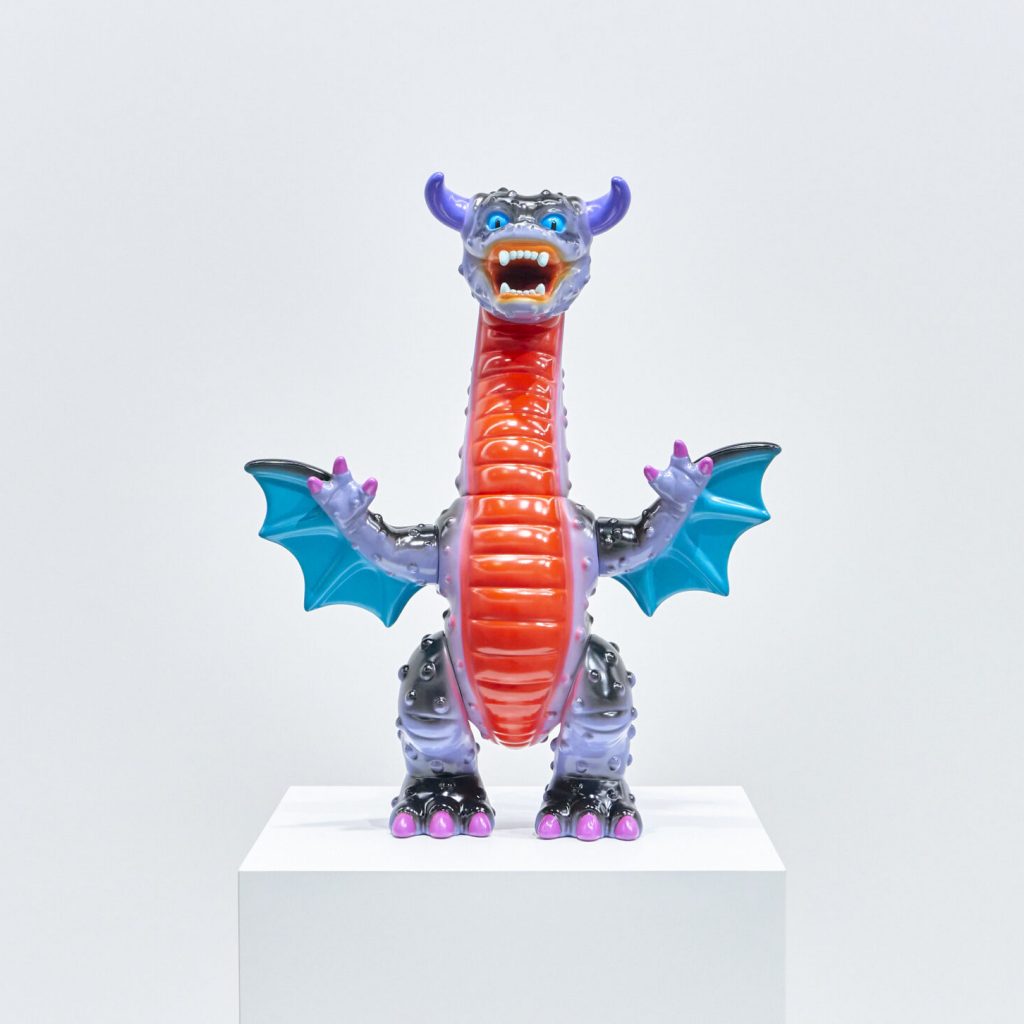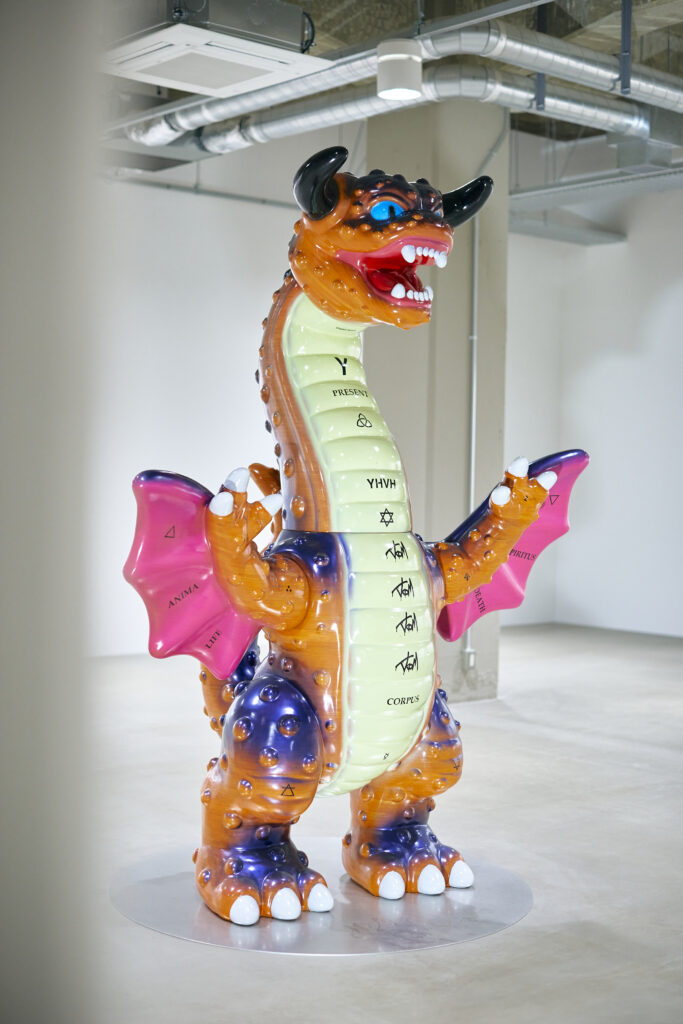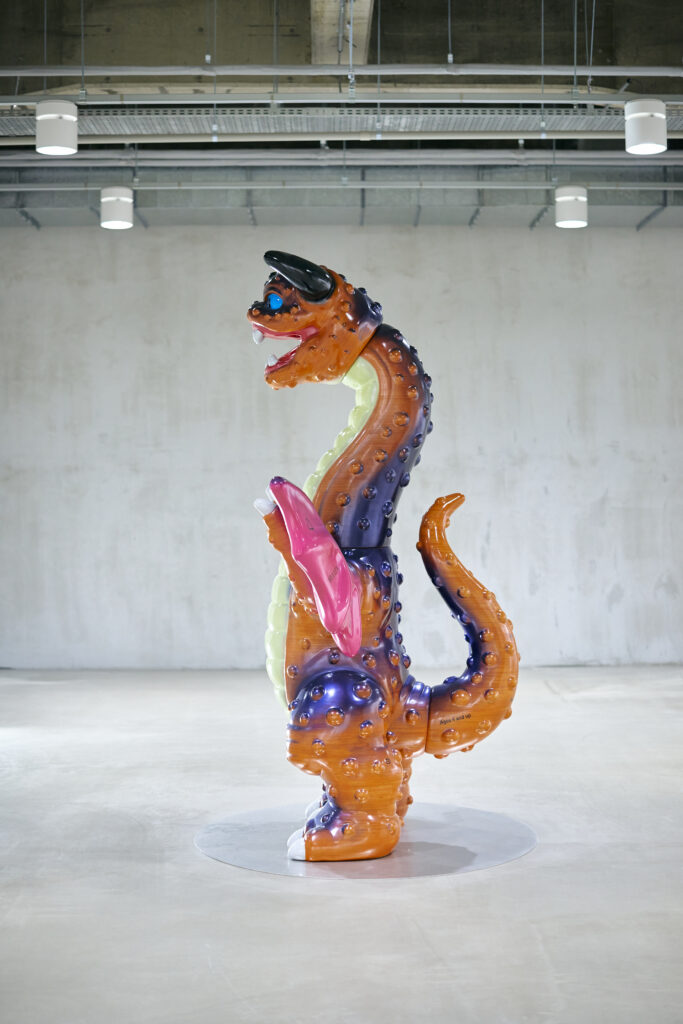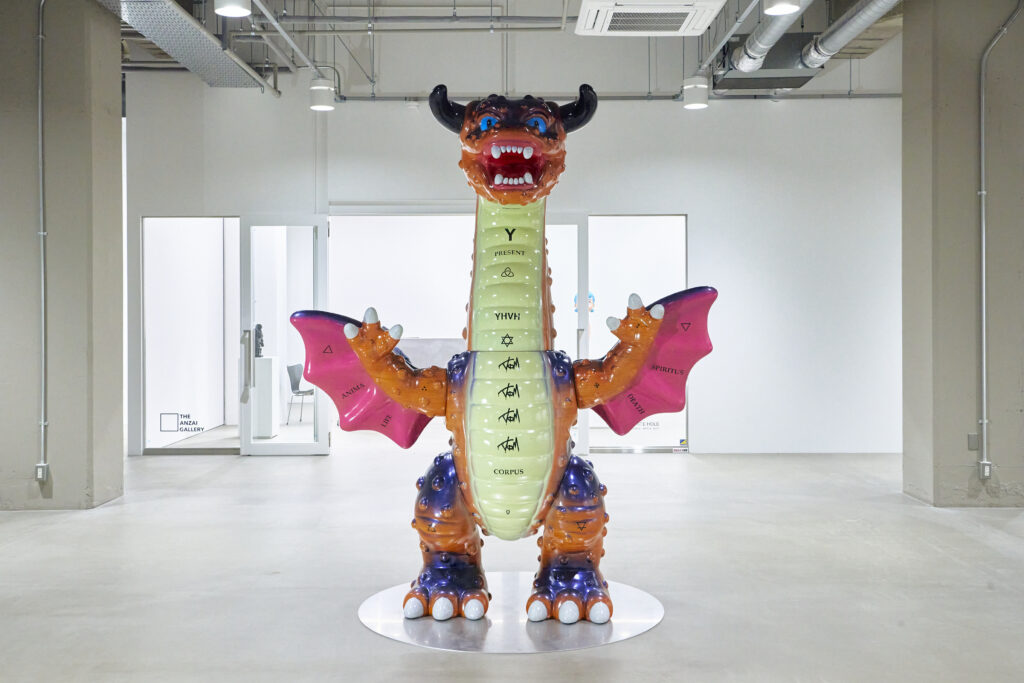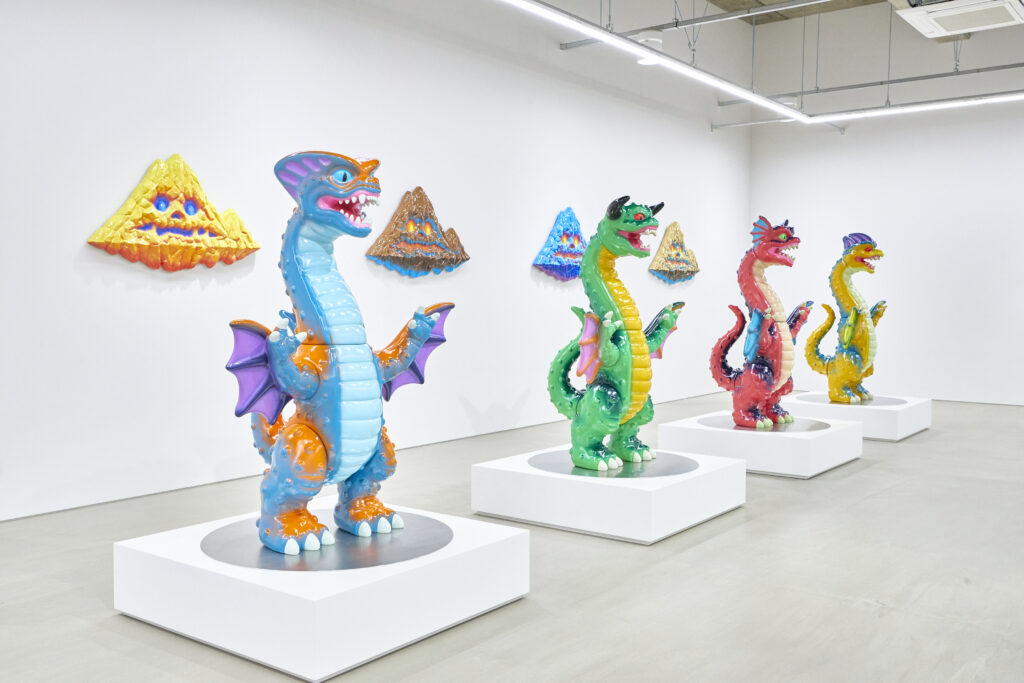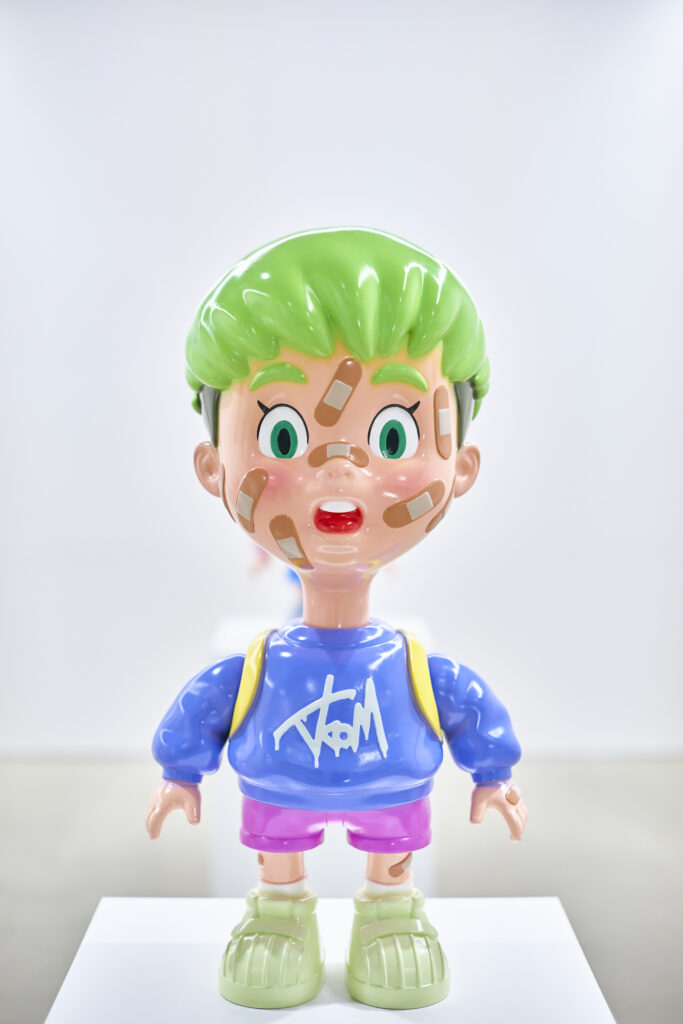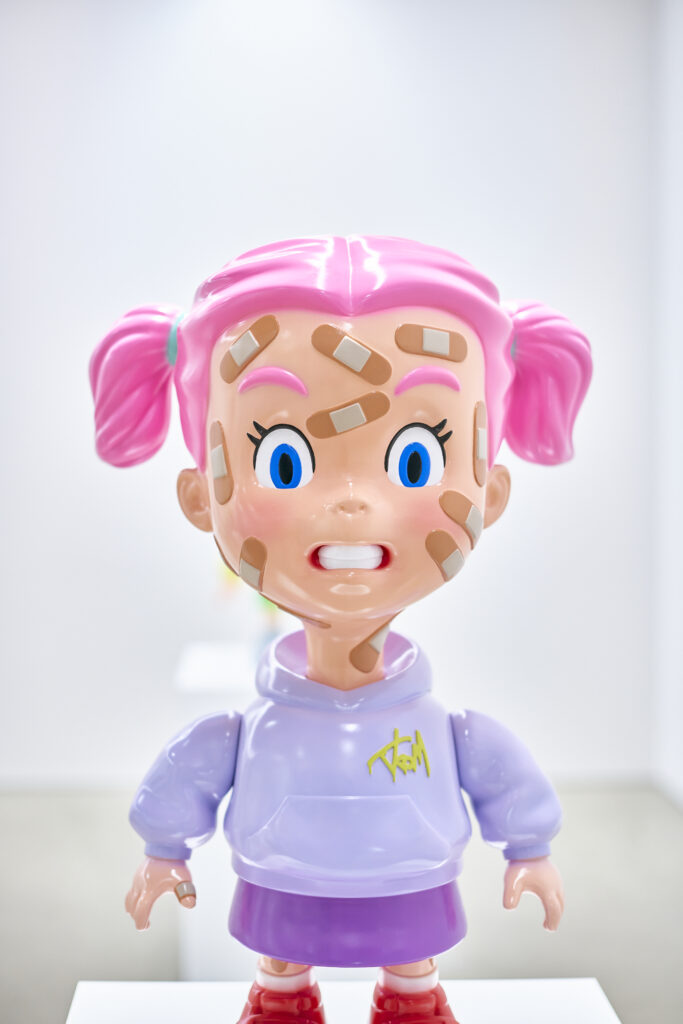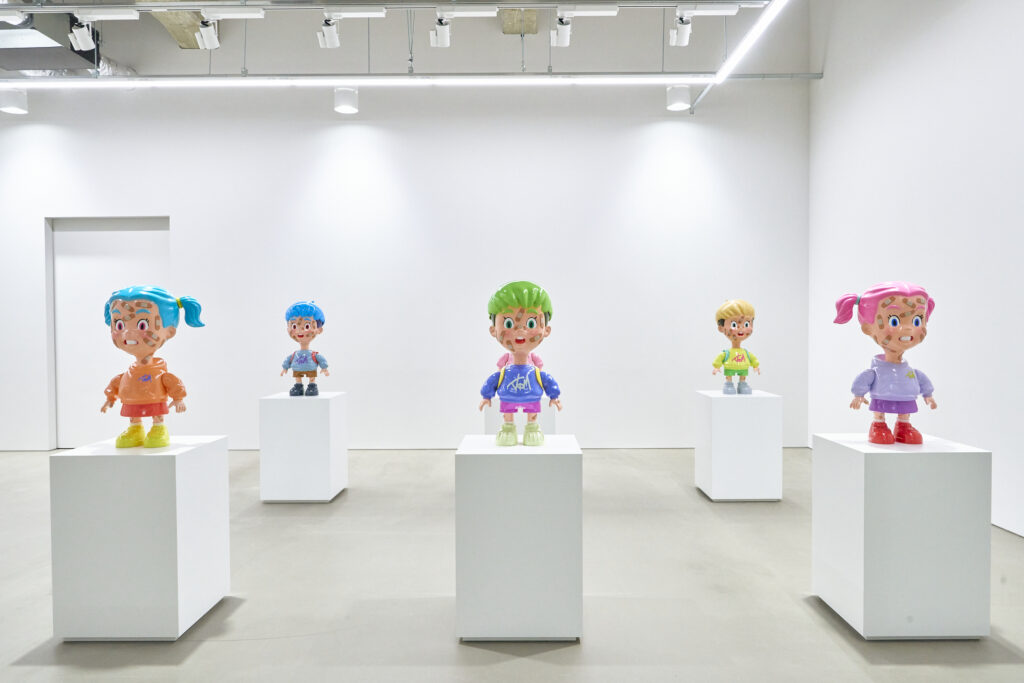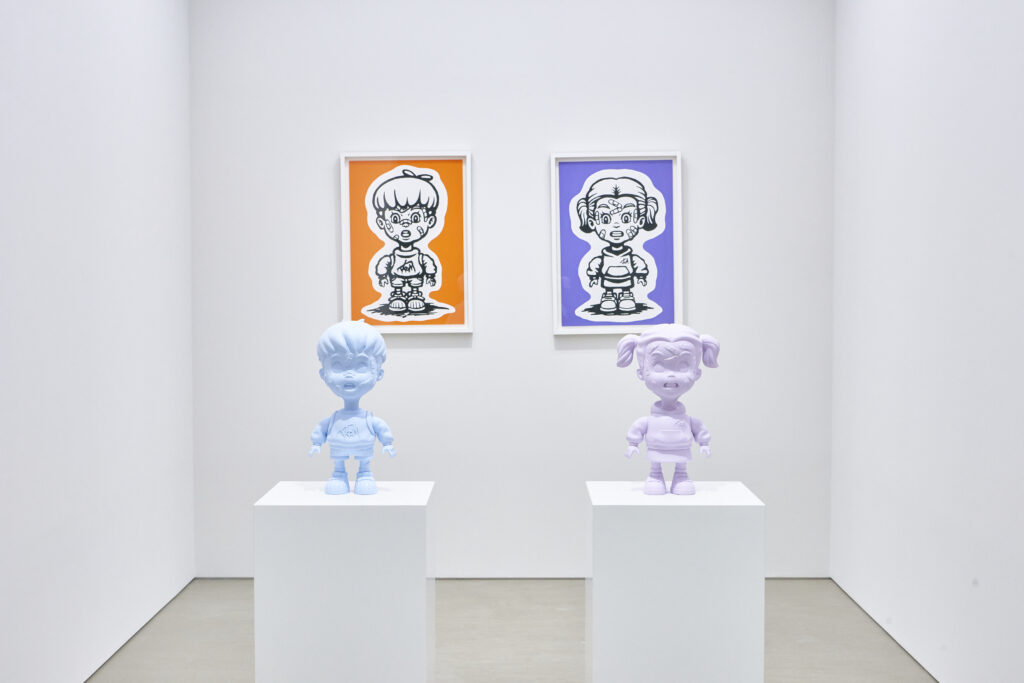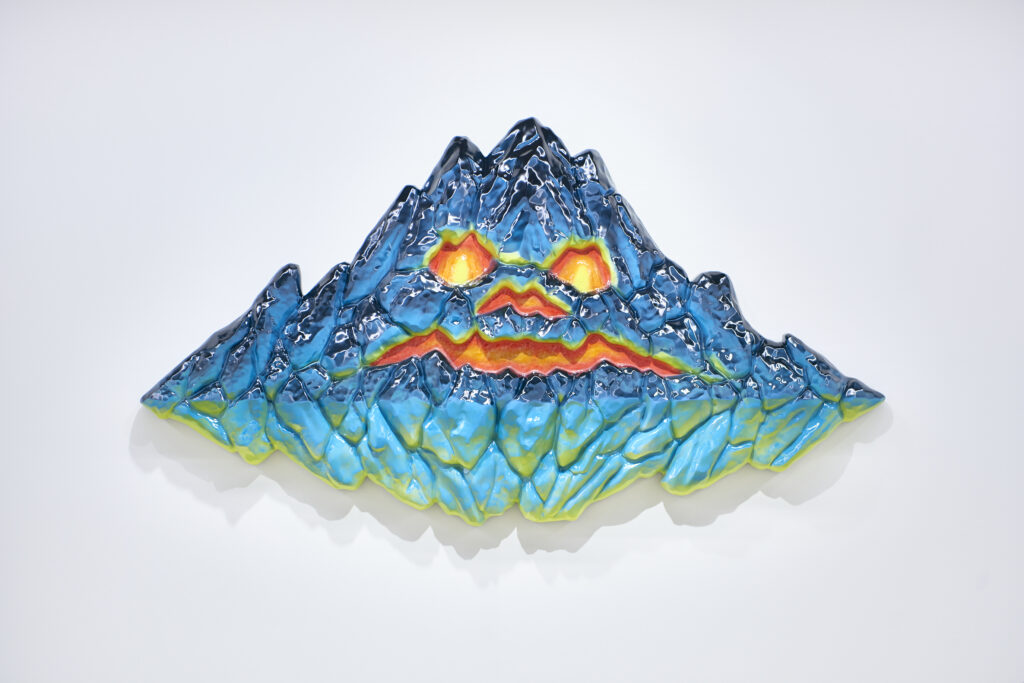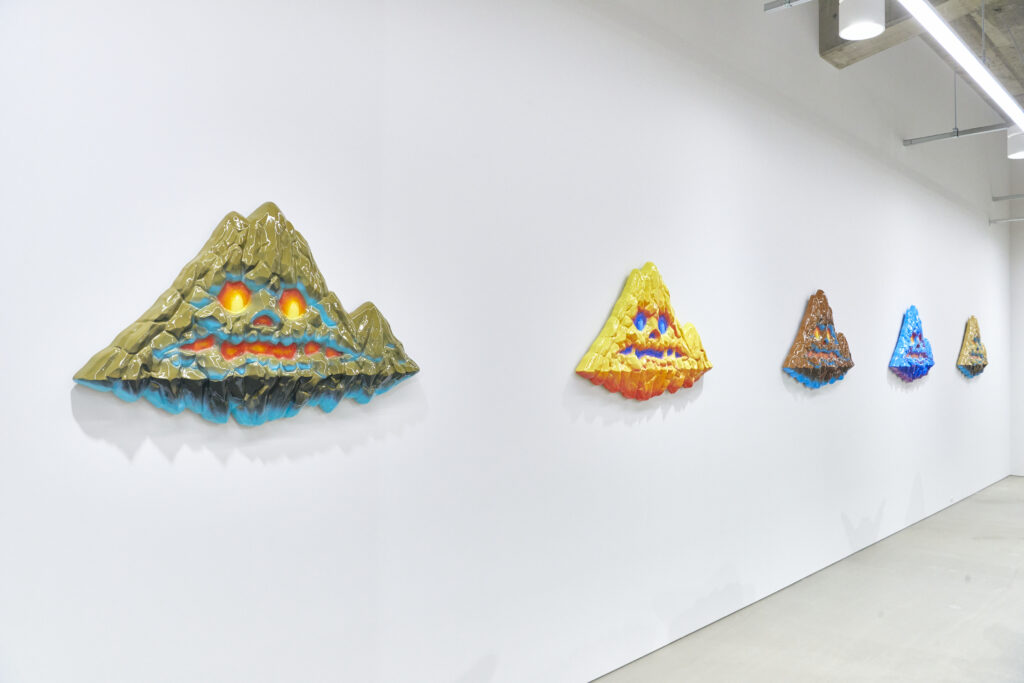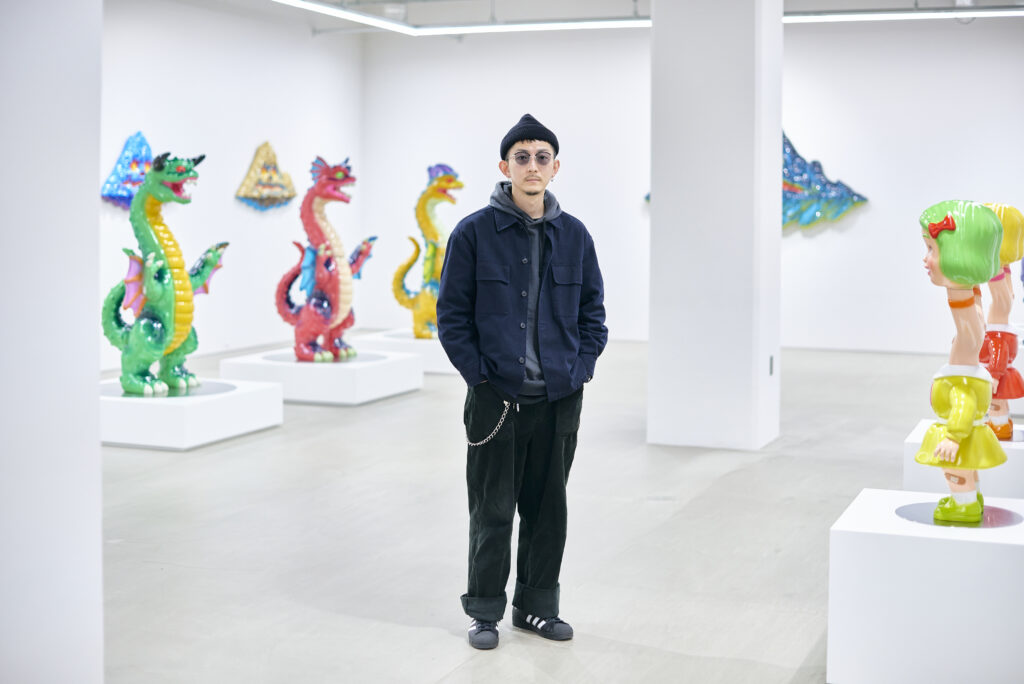In March, artist Takahiro Komuro held a large solo exhibition of his accumulated artworks, White Hole, at The Anzai Gallery. Based on his childhood origins, he creates unique sculptures influenced by American comics and figurines. Further, at one point, he had gained popularity abroad as a soft vinyl artist and continues to be on the rise domestically and internationally today.
How did his art style come about? He claims religions played a part. He spoke to us about his personal history and process and the art market bubble.
The very act of creating sculptures is holy
——While you look back on your personal history, I’d first like to talk to you about creating art. Could you start by explaining how you began making art?
Takahiro Komuro (Komuro): I was born in Ōta-ku, Tokyo, in 1985 and grew up around Haneda airport until the third grade. That area is downtown, with many metalworking factories, so I’ve seen artisans make things since childhood. Because I grew up in an environment where people made things, I naturally developed an interest in that. From a young age, I would rebuild toys and create things with clay.
——You enrolled in the Department of Sculpture at the Tokyo University of the Arts. Why did you choose that department?
Komuro: I liked three-dimensional objects. I was strongly attracted to the very act of touching tangible materials and making something rather than drawing. I presume the sensation of making things and playing with them in my childhood, which I mentioned just now, stayed with me.
——When you got into the Department of Sculpture, was your style the same as your current one?
Komuro: Until the second year of university, I was like, “I’m going to use different materials.” And so, I used various materials such as metal, wood, rocks, clay, and such. Plus, the school really drummed the structure of the human body into my head. After learning about the basics, they suddenly told me I could make whatever I wanted. But I didn’t know what to make, so I thought of using American comics and figurines—familiar things from my upbringing—as motifs. That’s how I found my current style.
——In an earlier interview, you said that you used to play with Teenage Mutant Ninja Turtles and Transformers figurines as a child.
Komuro: Yes. Reading American comics and playing with figurines in the second grade were formative experiences. In the early 90s, the city was brimming with American culture. Toyshops in downtown Ōta-ku sold figures and comics like Turtles, Batman, and Transformers. I liked movies like E.T., The Terminator, Robocop, Jurassic Park, and Star Wars. I also like Sesame Street.
There was, however, a significant experience that led me to comics and figurines. This is a complex of mine, but when I was a teenager, I was a follower of a certain religion for a while. When I was 18, I thought, “I don’t have to believe in this god,” and that’s when I stopped believing in it. This religion that served as the foundation of my identity was suddenly gone. So, from the age of 18, I started filling in the void of my identity. I looked back [at my life] and realized that I was at my purest until the second grade. When it came time to make artwork in university, I felt like the things I saw during that pure period were very sacred.
Most ancient statues symbolize gods, like Buddhist statues, Greek sculptures, and clay figures from the Jōmon era. I started making holy statues of comics and figurines, which were precious to me when I was a second-grader, with a similar sensibility to [ancient sculptors].
——When you make sculptures, it’s like you’re making Buddhist statues?
Komuro: Yes. I see the very act of making sculptures as a holy act. For me to continue doing this work, I see it as the most fundamental point. It’s not like I believe in a particular god, but it feels like I’m offering something to a higher power.
——I see. Were you influenced by Japanese figurines or anime at all?
Komuro: Ultraman, Kamen Rider, and such didn’t quite do it for me. American animations are more colorful, and they’re not just about cool or cute qualities. They also have gross and grotesque aspects, and I was drawn to that. Having cuteness and fear at the same time is appealing, and so I try to incorporate those elements into my work as well.
Valuing sizes— “What if something this big existed?”
——Regarding your process, do you first make a mold?
Komuro: In my early days, I would first make a prototype with clay and then replace that with plastic. After learning how to use computer graphics, I started making a prototype using computer graphics and then replace that with the most suitable materials. With sculptures, I make them with wood based on the computer graphics data, and with bronze pieces, I make a prototype with a 3D printer and then hand that over to a caster and have them make it. I also use materials like fiber-reinforced plastic and soft vinyl.
——You have gigantic pieces, but what are you particular about in terms of size?
Komuro: Every artwork has its optimal size, and even if the shape is the same, the impression of the work could change drastically depending on the dimensions. Usually, life-sized pieces feel just right. I place importance on sizes that make me go, “What if this were to exist?”
——The soft vinyl-like texture of your work is impressive.
Komuro: I liked how soft vinyl felt when I used to play with them, and so I recreate that smooth texture in my work. When there’s glossiness, the light will bounce back 100%. I like how that gives a strong impact too.
——A lot of your work incorporates dragons and children as motifs.
Komuro: Dragons are universal characters that appear in many stories. That’s why I had wanted to make one, eventually. But they show up in many different contexts, so in a way, I challenged myself to see what sort of dragon I could come up with. Dragons have vastly different interpretations in the west and east. The west sees them as evil, and the east sees them as gods. That difference is so interesting. I thought about the balance of making cuteness, scariness, and coolness coexist.
Regarding the two-faced girl, most of the imagery of my work is boyish, but I like cute things too. The Barbie or Licca dolls my sister used to play with were formative for me. Also, there were punk rock cover art or cute illustrations—for kids—of people with two heads. That surprise factor was nice. Those things inspired the fantastical sculptures of girls I make. Cute but shocking, a sense of discomfort—I think it’s nice that each person feels differently about art, whether it’s cute or scary.
The girls and boys with band-aids on are like alter egos of my second-grade self. When I was a second-grader, I would run around and get hurt all over while playing every day. Figurines had a more demanding presence than adults could see. Everything I experienced was astonishing, and I wanted to crystalize that. That’s why I called this artwork Eternal youth.
——What about your volcano piece?
Komuro: That’s an anthropomorphism of a volcano. To me, volcanos are mystical. I thought an impossible sight of a volcano flying would be funny, so I made it.
——All your works have distinct colors.
Komuro: I worry about colors the most. It’s so hard. If I fail with the colors, then everything goes wrong. There are cases where it becomes immediately better. That’s why I get torn and worried about it. But I like colorful, loud colors with stark contrast and saturation.
Presence and tangibility add strength to artworks in the digital age
——You also make soft vinyl figures, yes?
Komuro: Soft vinyl culture is an essential element to me. Four years after graduating from university, I suddenly stopped getting art jobs. I didn’t have the opportunity to show my art or make money, and just when I was like, “Shoot, this is bad,” an American company emailed me asking if I wanted to make soft vinyl figures. I had nothing else to do, so I said yes and went to America right away and made soft vinyl figures. When I sold those in America, they became quite popular.
From the early to mid-2010s, there was a lowkey soft vinyl trend in America. Until then, I had been making sculptures, but they weren’t selling so well. But the second I switched to soft vinyl, everything fell into place, and they sold so well. From that point, I started creating personal soft vinyl figures. I made and sold them whenever I didn’t have money for around four years.
At the time, the soft vinyl world was a microcosm of the art world, and they weren’t just seen as toys but financial products with the potential to profit. It was interesting to see the prices go up and up in the secondary market. The soft vinyl trend stopped abruptly in America, and that moved to Asia. Today, it’s mainstream in China.
——People have recently been saying we’re in an art market bubble, not limited to soft vinyl figures.
Komuro: I certainly think we’re in a bubble. Sneaker and soft vinyl resellers are starting to enter the art world right now. The value of artworks is blurring in this era.
I don’t think this bubble is going to last long, though. The art market bubble has a ten-year cycle, and once it bursts, unprecedented artists come out. For instance, we suddenly stopped seeing some active artists from the 2000s because of the Lehman shock. Some trends of that period are obsolete today. How can artists succeed and create universal art that could survive the bubble? I think that’s the real challenge.
——Has covid influenced your art-making process?
Komuro: In terms of work, it hasn’t had a significant impact. However, it reinforced the notion that what you thought of as normal could crumble one day and that the world could change 180 degrees. I believe we’ve entered a phase of turbulent changes. Sculptors could only create around four sculptures a year if they just used their hands. Back then, you could get away with having a solo exhibition once every two years, but that doesn’t work today. You have to have a show at least once every six months to survive. The thing you had faith in half a year ago might not resonate with the world six months after. The only thing you can do is speed things up. You have to accept the evolving technology as much as you can, and you must change too.
——What do you think is the influence of art, as well as what it can do in this unstable situation?
Komuro: Regarding sculptures, I’d say it’s about the power of definiteness, presence, and tangibility. The existence of beautiful sculptures existing in a particular space provides comfort to the soul. The same goes for Buddhist statues. I hope I could share that feeling with many people.
Moreover, art is about doing things you usually wouldn’t do; the impossible, the useless. You’re also paying the maximum amount of service by using all of your physical strength. Art is the accumulation of energy. Viewers of art could also receive that energy.
——That’s the exact opposite end of making money efficiently during a time of crisis.
Komuro: Sculptures are the embodiment of expenses. You spend the most time, money, and labor. But that’s why it’s powerful. As of recent, NFT (non-fungible token; a digital asset that uses blockchains) art and digital art are being celebrated, but they don’t click for me at all. Tangible objects have way more information than digital objects, and people can feel many things from them. I want to continue creating things with substance.

Takahiro Komuro
Born in Tokyo in 1985. In 2011, Takahiro Komuro graduated from the Tokyo University of the Arts, Department of Sculpture, with a master’s degree. He creates sculptural pieces, taking inspiration from 80s-90s American sci-fi, dystopian films, art toys, and figurines, and incorporating modern Japanese culture.
https://www.tkomsculpture.com
Instagram:@tkomfactory
Photography Yohei Kichiraku
Translation Lena Grace Suda

